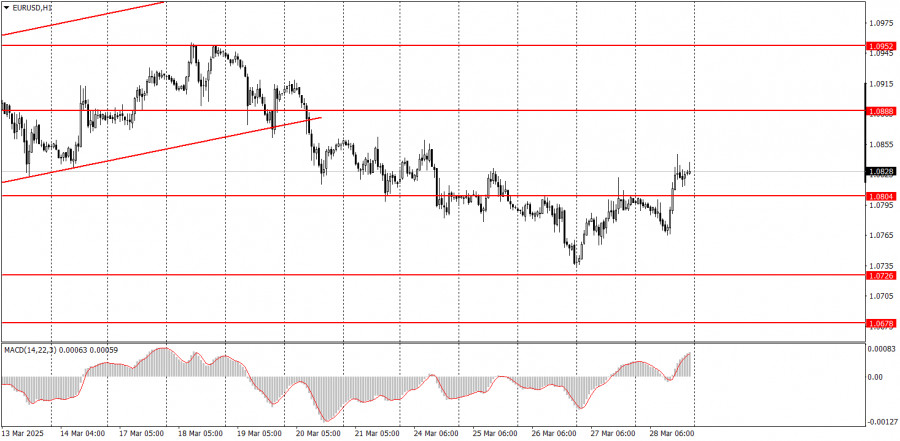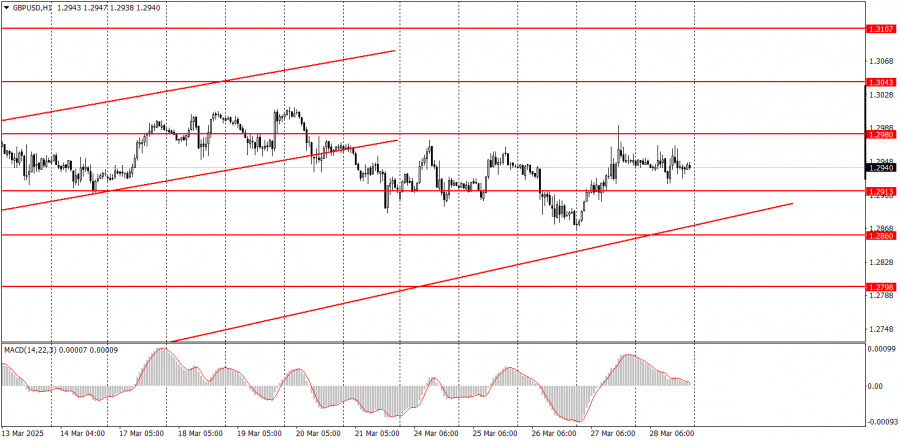What to Pay Attention to on March 31? A Breakdown of Fundamental Events for Beginners

Fundamental analysis
2025-03-31 01:21:16
Analysis of Macroeconomic Reports:

There are very few macroeconomic events scheduled for Monday. The only somewhat interesting reports will come from Germany. Retail sales and inflation data for March will be released. However, we'd like to remind you that Germany is just one of 27 countries in the European Union, so EU-wide indicators are naturally much more important for the euro. Nevertheless, German inflation data allows for a relatively accurate forecast of eurozone inflation overall. The Consumer Price Index is expected to remain at 2.3% for March.
Analysis of Fundamental Events:

There are no significant fundamental events scheduled. No speeches from central bank representatives of the EU, UK, or US are planned. No other fundamental developments are expected either. As a result, Monday is shaping up to be quite uneventful. However, let's not forget that Donald Trump remains the market's most powerful driver. Last Thursday, he imposed tariffs on car imports, and on April 2, he may introduce an additional package of tariffs against several countries around the world, mainly targeting the European Union.
General Conclusions:
On the first trading day of the new week, both currency pairs may resume the declines that have been building over recent weeks. However, the upcoming week will be filled with significant news and data releases, so traders won't be able to ignore everything. On top of that, Donald Trump is planning to "liberate America." Presumably from unfair treatment — but in practice, this means new tariffs. In short, both currency pairs may experience significant volatility in the week ahead.
Key Rules for the Trading System:
- Signal Strength: The shorter the time it takes for a signal to form (a rebound or breakout), the stronger the signal.
- False Signals: If two or more trades near a level result in false signals, subsequent signals from that level should be ignored.
- Flat Markets: In flat conditions, pairs may generate many false signals or none at all. It's better to stop trading at the first signs of a flat market.
- Trading Hours: Open trades between the start of the European session and the middle of the US session, then manually close all trades.
- MACD Signals: On the hourly timeframe, trade MACD signals only during periods of good volatility and a clear trend confirmed by trendlines or trend channels.
- Close Levels: If two levels are too close (5–20 pips apart), treat them as a support or resistance zone.
- Stop Loss: Set a Stop Loss to breakeven after the price moves 15–20 pips in the desired direction.
Key Chart Elements:
Support and Resistance Levels: These are target levels for opening or closing positions and can also serve as points for placing Take Profit orders.
Red Lines: Channels or trendlines indicating the current trend and the preferred direction for trading.
MACD Indicator (14,22,3): A histogram and signal line used as a supplementary source of trading signals.
Important speeches and reports, which are consistently featured in the news calendar, can significantly influence the movement of a currency pair. Therefore, during their release, it is advisable to trade with caution or consider exiting the market to avoid potential sharp price reversals against the prior trend.
Beginners in the Forex market should understand that not every transaction will be profitable. Developing a clear trading strategy and practicing effective money management are crucial for achieving long-term success in trading.
Смотрите также





